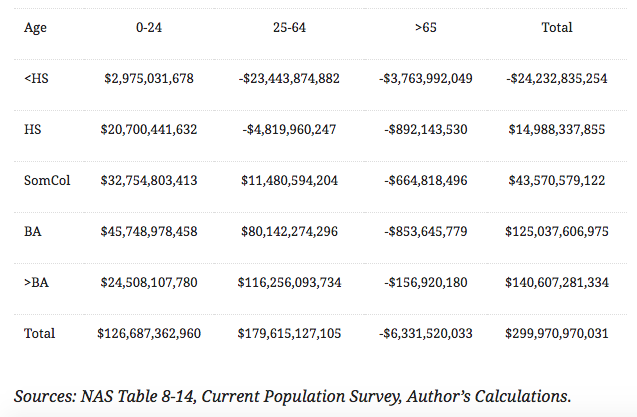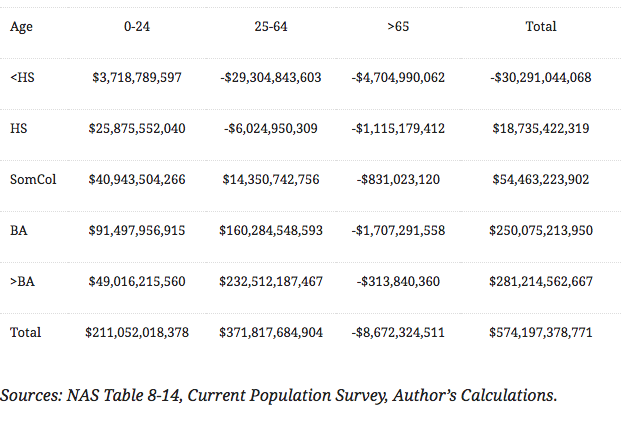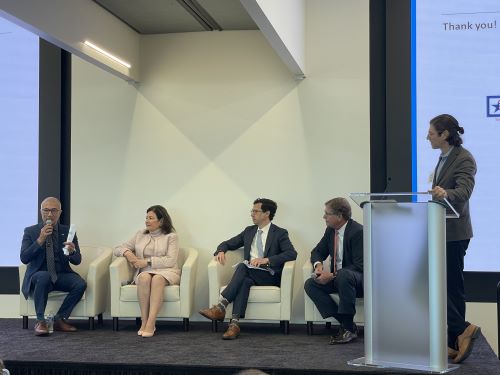The RAISE Act Would Hurt U.S. Taxpayers
 Robert Rector of the Heritage Foundation recently argued that the RAISE Act, a bill introduced by Senators Cotton (R-AR) and Perdue (R-GA), would save taxpayers billions by reducing lower-skilled immigration. Below I will argue that the RAISE Act does no such thing mainly because it does not actually increase skilled immigration, does not much alter the current education level of immigrants in the United States, and would result in removing at least 500,000 H-1B visas within a year of passage. Using the National Academy of Science (NAS) fiscal estimates, the RAISE Act is more likely to increase deficits over the next 75 years than to decrease them.
Robert Rector of the Heritage Foundation recently argued that the RAISE Act, a bill introduced by Senators Cotton (R-AR) and Perdue (R-GA), would save taxpayers billions by reducing lower-skilled immigration. Below I will argue that the RAISE Act does no such thing mainly because it does not actually increase skilled immigration, does not much alter the current education level of immigrants in the United States, and would result in removing at least 500,000 H-1B visas within a year of passage. Using the National Academy of Science (NAS) fiscal estimates, the RAISE Act is more likely to increase deficits over the next 75 years than to decrease them.
Rector makes two main claims in his post. The first is that “[b]ased on the National Academy of Sciences’ estimates, the average low-skill immigrant (with a high school degree or less) who enters the country imposes a net present value on taxpayers of negative $142,000.” A fiscal net present value (NPV) means that each immigrant in this education range would have to deposit $142,000 upon arrival that would earn 3 percent compounded annual interest to cover the full cost of social services that he or she will be expected to consume over the next 75 years. The second claim is that the RAISE Act could save taxpayers at least $1 trillion by cutting the flow of immigrants with a high school degree or less. The sections below will analyze these claims by using the National Academy of Sciences’ estimates and information from the Current Population Survey of the U.S. Census (CPS).
The Fiscal Net Present Value of Individual Low-Skilled Immigrants and Their Descendants
An immigrant’s education and age of immigration are the two most relevant characteristics used by the NAS to estimate his fiscal NPV. The more educated and younger the immigrant is, the more positive his fiscal impact. Table 8-14 in the NAS shows that age is very important—as almost every fiscal estimate looking at immigrants alone or immigrants plus their descendants has a positive fiscal NPV for those who immigrated between ages 0 and 24. However, all immigrants have a negative NPV if they entered at age 65 years or older, regardless of education. There is variation here, of course, as it is more fiscally positive for a high school graduate to immigrate at age 19 than age 17 as it will save taxpayers at least one year of public schooling, but those numbers are not reported in the averages for NAS’ broad age ranges.
Despite Rector’s first claim, the NAS does not have a 75-year fiscal projection that finds a fiscal NPV of -$142,000 per immigrant with a high school degree or below for the local, state, and federal governments. It is unclear how he calculated that figure based on the NAS findings.
My analysis uses the total impact results for immigrants and their descendants for the consolidated federal, state, and local governments in NAS table 8-14 that excludes public goods, just as Rector recommends, and adjusts for the age and eventual education of the new immigrants. The adjusted NAS 8-14 table is displayed here in Tables 1–3. This exercise is carried out under the same two budget scenarios provided by the Congressional Budget Office (CBO) and an additional unrealistic scenario that assumes that current budgets, benefits, and tax rates will continue with no adjustment despite the looming entitlement crisis.
Roughly 62 percent of immigrants with less than a high school education are younger than 18. Tables 1–3 make two adjustments. First, they conservatively estimate that those under the age of 18 will eventually be as educated as older immigrants who arrived in the same years. Second, they adjust for the immigrant age of arrival based on 2013-2016 CPS data. Those two minor adjustments produce an average NPV of -$24,233 per dropout immigrant in the best CBO estimate (Table 1). Those adjustments mean that an immigrant with only a high school education has an NPV of +$14,988. According to this calculation, the fiscal NPV for the average immigrant with a high school degree or less is -$9,244—94 percent below Rector’s estimate of -$142,000.
Averaging results over the three different budget scenarios mentioned above barely worsens the outcomes. The average fiscal NPV of an individual immigrant falls to -$27,700 for dropouts and +$7,275 for high school-only graduates. The average fiscal NPV for dropouts and high school graduates across these three budget scenarios is -$20,426—86 percent below Rector’s estimate.
Table 1
NPV Fiscal Impact on Federal, State, and Local Government, CBO Long-Term Budget Outlook, by Age and Eventual Education at Arrival.


Table 2
NPV Fiscal Impact on Federal, State, and Local Governments, CBO Long-Term Budget Outlook with Deficit Reduction, by Age and Eventual Education at Arrival.


Table 3
NPV Fiscal Impact on Federal, State, and Local Government, No Budget Adjustment, by Age and Eventual Education at Arrival.


Cut Benefits for Immigrants
Robert Rector is famous for his work on America’s bloated means-tested welfare state. Although the benefits sections in Tables 1–3 include more than welfare, a mere 10 percent cut in the NPV of benefits for only immigrants (not for their descendants) slashes the average fiscal NPV for immigrant dropouts in Table 1 by 52 percent and increases the surplus by 80 percent for high school-only graduates. This 10 percent cut in the NPV of immigrant benefits adjusts the average fiscal NPV for each dropout and high school-only graduate is +$15,441—a whopping $157,441 more positive than Rector’s estimate.
The average fiscal NPV across all three budget scenarios for high school graduates and below when the NPV of immigrant benefits is cut by 10 percent is -$12,197—a mere 9 percent of Rector’s estimate. That number includes the wildly unrealistic assumption that government spending can continue at its present unsustainable growth rates for the next 75 years. Reducing government benefits for immigrants, or everybody for that matter has a large and immediate positive fiscal impact on the future flow and the stock of immigrants already living in the United States.
Fiscal Net Present Value of the Current Immigration System, the RAISE Act, and Increased Legal Immigration
My simple analysis in this blog post misses many details about the RAISE Act. For example, the RAISE Act would have a negative fiscal impact by shrinking the stock of skilled foreign workers by forcing at least 500,000 H-1B workers out of the current green card backlog and out of the country in its second year. H-1B workers can extend their work permit on an annual basis if they are currently in line for a green card. Since RAISE would boot them out of the green card line after a year, H-1B workers will be unable to extend their work visas on an annual basis and will be forced to leave. If they have enough points for a green card then they will have to wait overseas. Those 500,000 workers have about as many spouses and minor children who are likely to be either highly educated or to become so. Removing so many skilled workers on H-1B visas would have a large and immediate negative fiscal impact that is not captured in this simple model.
This section uses the NAS Table 8-14 CBO Long Term Budget Outlook for Immigrants and their descendants to look at the impact on budgets for the combined state, local, and federal governments for a single year of legal green card immigration. I make the same assumptions as in the above section for looking at the current immigration system, how the flow of immigrants would change under the RAISE Act, and under a hypothetical doubling of immigrants with at least a college degree combined with a 25 percent increase in immigrants with some college education or less. The last scenario is a skills-boosting legal immigration reform that provides an alternative policy point as a comparison. In those two scenarios, I assume that any shift in future immigration is proportional to the age ranges that are currently entering so that any percent shift in the number of immigrants under one scenario is applied proportionately across all ages in every other scenario. This section does not look at the stock of current immigrants as that would remain unchanged under each iteration.
Some of the following numbers may seem huge but they are actually small in comparison to the 75-year NPV of $320.3 trillion for local, state, and federal budgets, assuming a 1.5 percent growth rate in budgets at a 3 percent discount rate.
Current Immigration Policy
This section assumes a million green cards is the current policy. Although that number is not set in law, that is about the average over the last several years. The fiscal NPV of all immigrants that year is +$299.9 billion (Table 4).
Table 4
Current Immigration System, One Year, NPV Fiscal Impact on Federal, State, and Local Government, CBO Long-Term Budget Outlook, by Age and Eventual Education at Arrival.

RAISE Act
For future annual flows under the RAISE Act, I assume a proportional 50 percent increase in immigrants with at least a college education and a corresponding drop in those with a high school degree and below. Even with that, the number of new immigrants with at least a college education under RAISE would be more than 100,000 below what it is under the current system. Thus, the annual fiscal NPV for the RAISE Act is +$222.9 billion—$77.1 billion below the current system (Table 5). Any fiscal gains from decreasing the low-skilled immigrant flow would be overwhelmed by fiscal losses from the RAISE Act’s indirect decrease in the number of skilled immigrants from cutting family reunification.
The RAISE Act’s NPV of these annual flows is +$6.7 trillion over the next 75-years discounted at 3 percent—a staggering $2.3 trillion below the current system’s 75-year fiscal NPV of just over +$9 trillion.
Table 5
RAISE Act, One Year, NPV Fiscal Impact on Federal, State, and Local Government, CBO Long-Term Budget Outlook, by Age and Eventual Education at Arrival.

Double Skilled Immigration and 25 Percent Increase in Lower Skilled Immigration
Congress could also decide to increase legal immigration with a heavy emphasis on more skilled workers without cutting family reunification or other immigrant categories. Using the same tools and assumptions employed above, a 50 percent increase in the number of skilled immigrants and a 25 percent boost in the number of low-skilled immigrants produces the most positive fiscal effects: A one-year fiscal NPV of $574.2 billion (Table 6). The fiscal NPV in one year under this scenario is $274 billion above the current system and $351 billion above what would exist under the RAISE Act.
Table 6
Pro-Skill Immigration Increase, One Year, NPV Fiscal Impact on Federal, State, and Local Government, CBO Long-Term Budget Outlook, by Age and Eventual Education at Arrival

Wages
Another claim made in Rector’s piece is that “Low-skill immigration reduces the wages of similar U.S.-born workers. An immigration-induced increase in the low-skill labor force of 10 percent can reduce the wages of low-skill non-immigrant labor by 3 to 10 percent.” The last paper that found that a 10 percent increase in immigration reduces wages by about 10 percent is a working paper by George Borjas and Joan Monras. Much of that paper is an extension of Borjas’ other work on the wage-effect of the Mariel Boatlift.
In addition to the finding that Rector reported, Borjas and Monras also found cross-skill complementarities whereby a 10 percent increase in the number of dropout immigrants increased the relative wages of native high school-only graduates by 7 percent. Since high school graduates earn about $180 per week more than dropouts do and there are about three times more of them (9.4 percent to 28.6 percent), the net wage increase is actually positive—as I re-discovered when re-creating Borjas’ results. Immigrants have a net positive effect on native-born American wages—especially on Americans with more skills. Anything more than a back-of-the-envelope fiscal analysis should consider those wage effects.
Conclusion
The RAISE Act will increase the deficit relative to current immigration policy when updated CPS data on new arrivals are applied to the findings of the National Academy of Sciences. A doubling of skilled immigrants, even if it is accompanied by a modest 25 percent increase in the flow of lower-skilled immigrants, almost doubles the fiscal benefit. Small cuts in benefits received by immigrants increase the fiscal benefits by large amounts.
The federal government faces a severe budget crunch in the near future due to the cash shortfalls in Social Security and Medicare. Immigration has increased net-revenues but not by nearly enough to offset the cost of the looming entitlement crisis. Tinkering with immigration flows is not a serious way to address government debt as only fiscal reforms to means-tested welfare schemes, entitlement programs, and other government expenditures can do that. The RAISE Act would worsen the federal government’s fiscal position even without considering how removing 500,000 skilled immigrant workers on H-1B visas within two years of enactment would affect revenues.
Republicans control both Houses of Congress and the Presidency. If they are serious about reducing the budget deficit then they need to tackle spending head on rather than playing around with the future flow of foreign workers through complex RAISE Act-like schemes that will actually make things worse. Furthermore, it is more likely that Congress will be able to reduce these benefits than pass the RAISE Act. Conservatives should jump at the opportunity to use immigration as a reason to cut the welfare state rather than using welfare as a reason to cut immigration.








